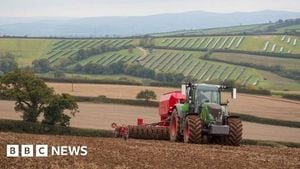As hurricane season ramps up in the eastern Pacific, two powerful storms—Hurricane Kiko and Tropical Storm Lorena—have captured the attention of meteorologists, coastal residents, and travelers across Mexico, the United States, and Hawaii. With both systems gathering strength and potential impacts looming, eyes are fixed on their paths and the risks they may bring in the coming days.
On September 2, 2025, the U.S. National Hurricane Center in Miami announced the formation of Tropical Storm Lorena off Mexico’s Pacific coast. According to the Associated Press, Lorena’s maximum sustained winds were near 45 mph (75 kph) as of Tuesday morning, with the storm centered about 240 miles (385 kilometers) west of Manzanillo, Mexico. The system was moving northwest at a brisk 14 mph (22 kph), and forecasters expected it to continue strengthening—potentially reaching hurricane status by Wednesday, September 3.
Meanwhile, further out in the Pacific, Hurricane Kiko was churning over open water, located roughly 1,840 miles (2,965 kilometers) east of Hawaii. As of September 2, Kiko was packing maximum sustained winds of 75 mph (120 kph), moving west at a slower pace of 7 mph (11 kph). The National Hurricane Center did not issue any coastal watches or warnings for either storm at that time, but the situation was evolving quickly.
AccuWeather’s Lead Hurricane Expert Alex DaSilva provided further insight into the developing situation, emphasizing that both Kiko and Lorena could have significant impacts on land and sea in the days ahead. "Hurricane Kiko will be entering an area where atmospheric conditions are conducive to strengthening," DaSilva explained. "It is not out of the question that Kiko can reach major hurricane status over the coming days." The forecast called for Kiko to reach Category 2 intensity on the Saffir-Simpson Hurricane Wind Scale by Wednesday evening, with the potential for further intensification.
Although Kiko was not expected to affect land through the remainder of the week, residents and visitors in Hawaii were urged to keep a close eye on updates. AccuWeather warned that if Kiko’s track shifted closer to the islands, impacts could be felt by the middle of next week—around September 10 or 11. Even if the storm remains offshore, increased surf and strong wave action are anticipated to reach Hawaii’s beaches, raising concerns for swimmers, surfers, and boaters alike.
Back on the Mexican coast, Tropical Storm Lorena was already making its presence felt. The storm developed late Monday night, September 1, and was forecast to track near the western coast of Mexico throughout the week. AccuWeather meteorologists predicted that Lorena would bring heavy rain and gusty winds to the region, with the potential to reach hurricane status by Wednesday evening. "Some rain could reach the southwest U.S. by the end of the week into the weekend, as the storm is expected to track inland across Mexico," DaSilva noted.
The risks associated with Lorena were not limited to wind and rain. Heavy rainfall was expected to spread across parts of western Mexico and into Baja California Sur during the second half of the week—between September 4 and 7. This deluge could trigger flooding, road washouts, and dangerous mudslides, posing threats to communities, travelers, and infrastructure. In addition to the rain, strong wind gusts were forecasted, with speeds reaching up to 80 mph and localized storm maximums (or AccuWeather Local StormMax™) of 90 mph across portions of Baja California Sur. Such powerful winds have the potential to cause tree damage and localized power outages, compounding the storm’s hazards.
The potential for Lorena’s moisture to reach the southwestern United States added another layer of concern. AccuWeather experts explained that rainfall totals across Arizona, New Mexico, and Texas would depend on the strength of a high-pressure system over the region. If high pressure remained dominant, rain would be limited. However, if the system weakened, heavier rainfall could spill into these states by the end of the week and into the weekend—potentially bringing much-needed moisture, but also the risk of flash flooding in vulnerable areas.
While Kiko and Lorena dominated headlines, meteorologists were also keeping tabs on another area of disturbed weather south of Mexico. According to AccuWeather, this region was being monitored for possible tropical development over the weekend into early next week, with the next name on the list being Mario. However, any development in this area was considered unlikely to impact land at this time.
The National Hurricane Center’s decision not to issue coastal watches or warnings as of September 2 did not mean that residents could let their guard down. Both storms were evolving rapidly, and their future tracks remained uncertain. AccuWeather’s DaSilva emphasized the importance of staying updated: "If this storm continues to track closer to Hawaii, impacts could be felt on the islands by the middle of next week."
For those living along the Mexican coast, in Baja California Sur, or in the southwestern United States, the approaching storms served as a reminder of the power and unpredictability of tropical weather. Local authorities and emergency managers urged residents to review their preparedness plans, secure loose outdoor items, and monitor official forecasts closely. The threat of flooding, mudslides, and power outages was real—and could escalate quickly if the storms intensified or tracked closer to populated areas.
In Hawaii, the anticipation was tinged with anxious watchfulness. While Kiko posed no immediate threat as of early September, the possibility of a shift in its path kept officials and residents on alert. The islands are no strangers to tropical systems, but every new storm brings its own set of challenges and uncertainties. Increased surf and strong wave action, even without a direct hit, can lead to dangerous conditions along the coast, prompting beach closures and water safety advisories.
As the tropics become more active, meteorologists stressed the value of reliable, up-to-date information. Tools like the AccuWeather app and National Hurricane Center advisories enable people to make informed decisions and stay safe during severe weather events. AccuWeather’s team of expert meteorologists monitor and analyze dangerous weather risks around the clock, issuing alerts and guidance as situations develop.
The coming days will reveal whether Hurricane Kiko strengthens into a major hurricane and how close it will come to Hawaii. Likewise, the evolution of Tropical Storm Lorena will determine the extent of its impacts on Mexico and the southwestern United States. For now, vigilance and preparation remain the watchwords as the Pacific hurricane season enters a volatile phase.
With two powerful storms swirling in the eastern Pacific and another disturbance on the horizon, the region is bracing for what could be a dramatic and challenging week. Whether these storms bring only high surf or more severe impacts, the next few days will test the readiness and resilience of communities across the Pacific Rim.




